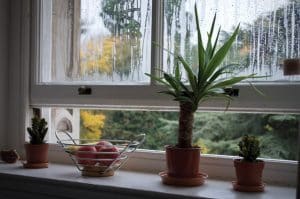We spend at least 70% of our time at home and yet the place where we spend the majority of our time – our sanctuary – could be harbouring a number of potential health hazards without you even being aware of them.

From airborne chemicals, dust mites, mould spores and potentially harmful chemicals to your cleaning products, air fresheners, cooker or central heating, these largely invisible allergens could be triggering headaches, sore throats, irritated eyes and respiratory problems like coughs, sore throats and asthma while exacerbating existing lung conditions like COPD.
Chemical overload
Most of us are aware that breathing in polluted air outdoors isn’t great for our health, but outside, surrounded by traffic and/or buildings pumping out fumes, we generally can smell or have a visual reminder of it. At home, we don’t. Airtopia indoor air pollution expert, Tim Robinson, points out features of modern homes, and the products we use in them, can seriously affect our air quality and have the potential to make us ill.
Log burners, laminate flooring and fitted units made from composite wood are just a small section of the things that can contribute to indoor air pollution. Poor ventilation, the way we cook, whether your house is damp and chemicals in our decorating or cleaning products and air fresheners can all similarly affect the quality of the air you are breathing at home. We are all potentially at risk but anyone with a respiratory or lung condition or children (whose lungs are still developing) are particularly vulnerable.
Exacerbating allergies and asthma
Tim Robinson adds, “The products we use to clean and decorate with often contain chemicals called VOCs – volatile organic compounds – like acetone and limonene – and it has been suggested that regularly breathing in these chemicals puts us at increased risk of exacerbating an allergy or triggering an asthma attack.
Even something as seemingly innocuous as cooking presents another slight concern as tiny particles are released into the air during the cooking process that can be inhaled. If you have a gas cooker you are more at risk as it can produce emissions like nitrogen dioxide and other by-products of combustion.”
What you can realistically do?
Hyper-ventilate. Sounds blindingly obvious, but air your house as much as possible by opening the windows daily for at least 10 minutes to make sure there is plenty of ventilation. Keep windows open when you are cleaning, cooking and/or decorating. For extra help, filter indoor air with a specially designed air purifier. Many models run on timers and leap into action when airborne pollutants are detected, and have quiet modes so that they can continue to run at night such as the VAX A200 Air Purifier or Blue Air.
Clean up, naturally. One of the simplest ways to increase the quality of air in your home (and you know this already!) is to keep everything as clean as you can BUT… choose your cleaning products with care. Many contain potent synthetic fragrance and VOCs like
formaldehyde. Check what is in your products (under current EU regulations formaldehyde should be clearly labelled). Where you can, avoid harsh spray products as these get into the air more easily and are more likely to get into your airways. Ideally make more eco-friendly choices like using the Ecover range to clean and/or choose natural ingredients like bicarbonate of soda, lemon juice and vinegar to clean with.
Filter air with care
Get incense sense. Incense sticks might smell good but they also emit pollutants as they burn and there is evidence linking regular incense burning and lung disease according to the British Lung Foundation.
Some scented candles also emit small amounts of formaldehyde and although the risk is thought to be small it is advisable to limit your use of them to special occasions and opt for ones that are organic (like NEOM organics).
Cooking on gas? Make sure any gas appliances are regularly maintained, install an extractor fan in the kitchen and always use it when cooking, open the windows regularly and install alarms that detect both smoke and carbon monoxide.
Don’t get too steamed up. Food that is steaming on the hob for ages, taking long steamy showers and drying damp clothes on the radiator are just a few of the things that can create or exacerbate condensation and potentially damp and mould. Try to keep the window open near food or water that is steaming and ideally dry your clothes outside. If your windows are prone to condensation wipe them down daily. If you do develop bad damp or mould anywhere in the house get a professional in to deal with it.
Dampen down dust mites. To reduce and/or get rid of dust mites dust with a damp cloth daily and try to reduce the amount of clutter that is likely to attract dust. Wash your towels and bedding in hot water once a week and keep your mattresses and pillows covered.
Clean upholstery and headboards, and vacuum carpets regularly and keep any hard floors clean with a specially designed hard floor cleaner like the Vax Glide which kills 99.9% of bacteria as it vacuums, washes and dries your floors.
Keep remedies to hand
Alison Cullen, A Vogel Nutrition Therapist and Education Manager says: “If you are generally prone to allergies and/or suffer with frequent allergic reactions (including hay fever) keep remedies to close to hand and try to nip symptoms in the bud with natural products like A.Vogel’s Pollinosan Luffa Nasal spray and/or Extra Moisturising Eye Drops and the good news is these can be taken alongside any existing medications.”
Feed your insides. Dr Sarah Brewer, Healthspan’s Medical Director says: “As well as keeping our homes healthy it is important to look after yourself to try and make yourself as resilient to allergens as you can. No one food or food group will make you allergen-proof but eating a well-balanced diet can help. Include plenty of vitamin C-rich fruits and vegetables and foods containing omega 3 fatty acids (found in oily fish like salmon and mackerel, nuts and seeds). If you feel you are not getting the necessary nutrients from your diet invest in a multi-vitamin supplement like Healthspan’s Multivitality Gold and keeping our gut and microbiome healthy is also vital with probiotics such as Healthspan’s SuperPro 50 containing four well researched strains and we know Bifidobacterium lactis declines as we age.
(Story source: 50 Connect)

